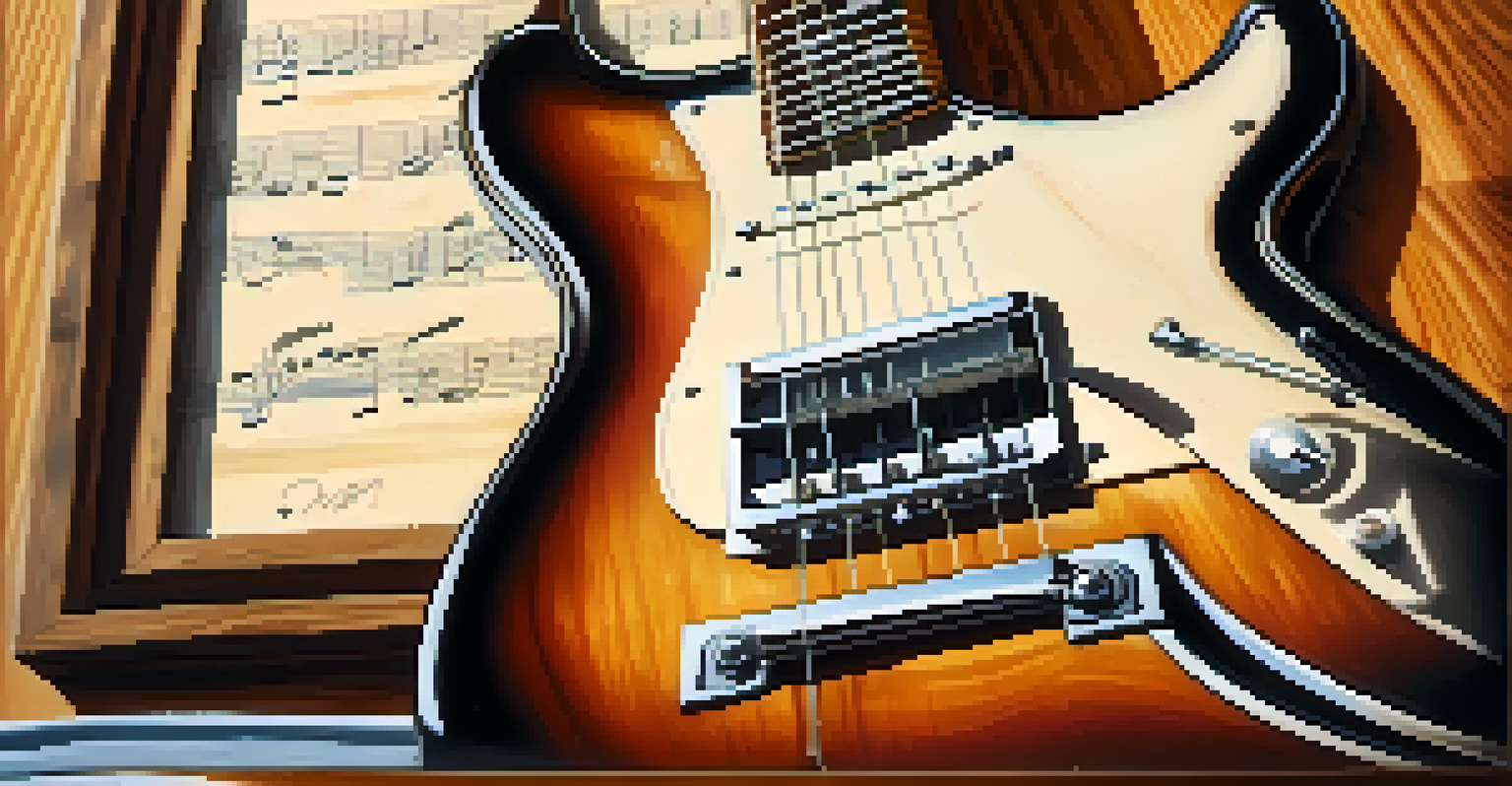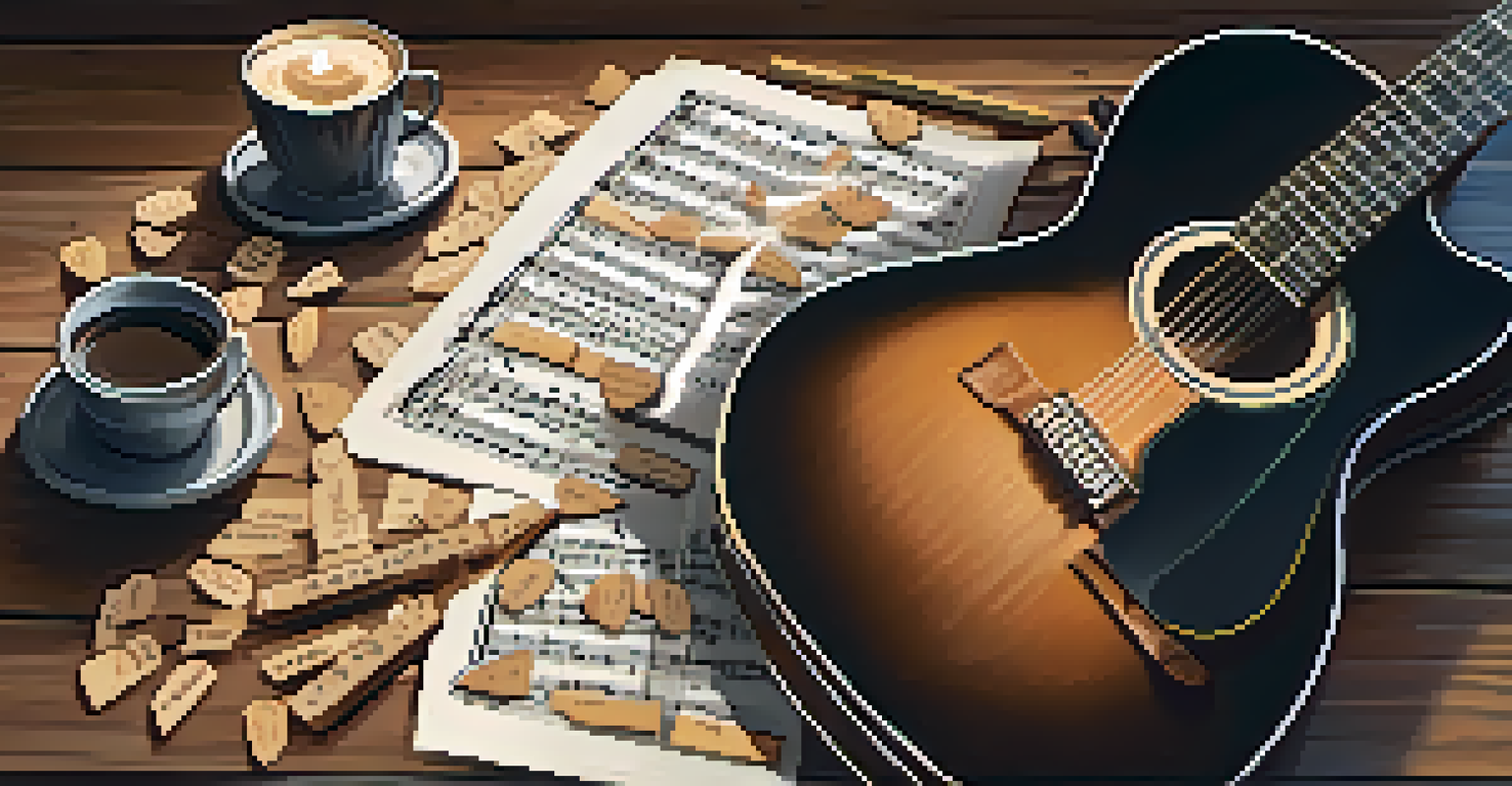Understanding Guitar Tablature: A Beginner's Guide to Reading

What is Guitar Tablature and Why Use It?
Guitar tablature, often called 'tab,' is a simple way to notate music for guitar players. Unlike standard musical notation, which can be complex, tab uses simple lines and numbers to represent the guitar strings and frets. This makes it accessible for beginners who may not have formal music training.
Music is the shorthand of emotion.
One of the biggest advantages of tablature is its straightforwardness. For example, if you see a '3' on the bottom line of the tab, it means you should press down on the third fret of the lowest string. This clarity allows players to quickly learn their favorite songs without diving deep into music theory.
In essence, tab provides a bridge for beginners to start playing music right away, making it a popular choice among aspiring guitarists. It's like having a map that shows you exactly where to go, rather than just a list of directions.
The Layout of Guitar Tablature Explained
When you look at a piece of guitar tab, you'll notice it consists of six horizontal lines, each representing a string on the guitar. The bottom line is the thickest string (E), while the top line is the thinnest string (e). This layout mimics how the guitar is held, making it easier to visualize.

Numbers placed on these lines indicate which fret to press. For instance, a '0' means to play the string open, while a '2' means to press the second fret. This intuitive design allows players to quickly understand their next move without needing to decipher complex symbols.
Understanding Guitar Tablature Basics
Guitar tablature simplifies music notation, making it accessible for beginners to learn their favorite songs.
Additionally, certain symbols may appear in tablature, such as 'x' for muted strums or 'h' for hammer-ons. These notations add depth to your playing and can expand your technique, making the learning process more engaging.
Reading Basic Guitar Tablature Notation
Reading guitar tab is quite simple once you get the hang of it. Start by identifying the string indicated and the fret number you need to press. For example, if the tab shows 'e|----0---', you would play the high E string open, without fretting any notes.
The beautiful thing about learning is that no one can take it away from you.
As you progress, you may encounter multiple numbers stacked above each other, indicating that you should play those notes simultaneously, known as a chord. Understanding how these chords fit together can help you play songs more fluently.
Ultimately, practice is key. The more you familiarize yourself with the layout and notation of tab, the easier it will become to read and play your favorite songs. Think of it as learning to read a new language—patience and consistency are essential.
Common Symbols Used in Guitar Tablature
Guitar tablature often includes various symbols that enhance your playing experience. For example, 'b' denotes a bend, where you push the string to change the pitch, while '/' signifies a slide from one note to another. These embellishments add flair and expressiveness to your music.
Additionally, you may come across 'p' for pull-offs, which allow you to transition between notes smoothly without re-picking the string. Understanding these symbols can open up a world of techniques that elevate your guitar playing.
Importance of Practice for Mastery
Consistent practice with guitar tabs is crucial for skill development and improving overall playing ability.
While it might seem daunting at first, learning these symbols can be quite rewarding. They provide the tools to express your musicality, transforming simple melodies into intricate pieces.
Finding Guitar Tabs for Popular Songs
One of the most exciting parts of learning guitar is playing your favorite songs. Fortunately, there are countless resources available online where you can find guitar tabs for almost any song you can think of. Websites like Ultimate Guitar and Songsterr host vast libraries of user-generated tabs.
When searching for tabs, it's essential to check the accuracy and the skill level indicated, as some tabs can vary in complexity. A beginner-friendly tab will help you enjoy the song without feeling overwhelmed and ensure you're playing it correctly.
Remember, playing along with your favorite tracks is a fantastic way to improve your skills. It not only boosts your confidence but also makes practice feel less like a chore and more like a fun activity.
The Importance of Practice in Learning Guitar Tab
Like any skill, mastering guitar tablature requires consistent practice. Start with simple songs that use basic chords and gradually progress to more challenging pieces as you gain confidence. Set aside dedicated time each week to practice, and you'll notice improvement over time.
Additionally, consider recording yourself while playing. This can help you identify areas where you might need more work and track your progress. It's also a great way to celebrate your achievements, no matter how small they may seem.
Understanding Guitar Tablature
Guitar tablature simplifies music notation, making it accessible for beginners with its straightforward lines and numbers.
Finally, don't forget to enjoy the process! Learning guitar should be fun, so incorporate songs that inspire you and keep your motivation high. The more you enjoy your practice, the more likely you are to stick with it.
Advanced Techniques: Expanding Beyond Basic Tabs
Once you're comfortable with reading basic tablature, it's time to explore more advanced techniques. This may include fingerpicking, harmonics, or even incorporating effects like distortion and reverb. These elements can enhance your sound and make your playing more dynamic.
You might also consider learning how to play by ear, which involves listening to a song and figuring out the notes without relying on tabs. This skill can deepen your understanding of music and improve your overall musicianship.

Remember, advancing your skills takes time and patience. Embrace the challenge and continue seeking out new techniques and styles to keep your playing fresh and exciting.